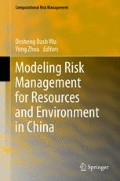Abstract
In order to solve the enormous difference about safe headway between the theoretical value from academic researches and the observational value from practical road conditions, this paper establishes a new vehicle-following model to accurately simulate the vehicle-following process. The model well simulates the actual situation, and provides an operable safety distance reference value for car drivers. Combined with the experiences of outstanding drivers, the model reengineers an integrated process as guidance including maintaining safe headway and changing traffic lane or braking. In addition, the paper discusses the limit of safe headway through sensitive analysis, and finds the reliable measures, so the safe headway could be shortened to improve the efficiency of road utilization. The broad applicability of the conclusion is verified by empirical data.
Access this chapter
Tax calculation will be finalised at checkout
Purchases are for personal use only
References
Cahlon B, Harband J (1979) A confidence headway for safe car-following. J Math Anal Appl 69:511–530
Chen X, Gao Z-Y (2007) Study on the two-lane feedback controlled car-following model (in Chinese). Acta Phys Sin 56:2024–2029
Dorn L (2003) Driver behaviour and training. Ashgate Publishing Limited, Hampshire
Evans L (1991) Traffic safety and the driver. Van Nostrand Reinhold, New York
Goto Y, Furusawa H, Araki M, Fukuda T (1999) A safe traffic speed control in AHS. In: Proceedings 1999 IEEE/IEEJ/JSAI international conference on intelligent transportation systems, pp 459–464. IEEE, Tokyo, 1999
Groeger JA (1998) Close, but no cigar: assessment of a headway warning device. In: Proceedings of the 1998 IEE colloquium on automotive radar and navigation techniques, pp 51–54. IEE, London, 1998
Han Y-c (1997) Driver reaction time test and its mathematical treatment (in Chinese). Psychol Sci 20:436–440
Kurata S, Nagatani T (2003) Spatio-temporal dynamics of jams in two-lane traffic flow with a blockage. Phys A Stat Mech Appl 318:537–550, Elsevier, Netherlands
Li X-L, Song T, Kuang H, Dai S-Q (2008) Phase transition on speed limit traffic with slope. Chin Phys B UK 17:3014–3020
Yu Z-p, Wang Y, Gao F (2009) Interval analysis method for safety distance of car-following (in Chinese). Trans Chin Soc Agric Machinery 40:31–35
Author information
Authors and Affiliations
Corresponding author
Editor information
Editors and Affiliations
Rights and permissions
Copyright information
© 2011 Springer-Verlag Berlin Heidelberg
About this paper
Cite this paper
Xue, H., Jiang, S., Li, Zx. (2011). The Analysis and Empirical Test on Safe Headway. In: Wu, D., Zhou, Y. (eds) Modeling Risk Management for Resources and Environment in China. Computational Risk Management. Springer, Berlin, Heidelberg. https://doi.org/10.1007/978-3-642-18387-4_18
Download citation
DOI: https://doi.org/10.1007/978-3-642-18387-4_18
Published:
Publisher Name: Springer, Berlin, Heidelberg
Print ISBN: 978-3-642-18386-7
Online ISBN: 978-3-642-18387-4
eBook Packages: Business and EconomicsBusiness and Management (R0)

